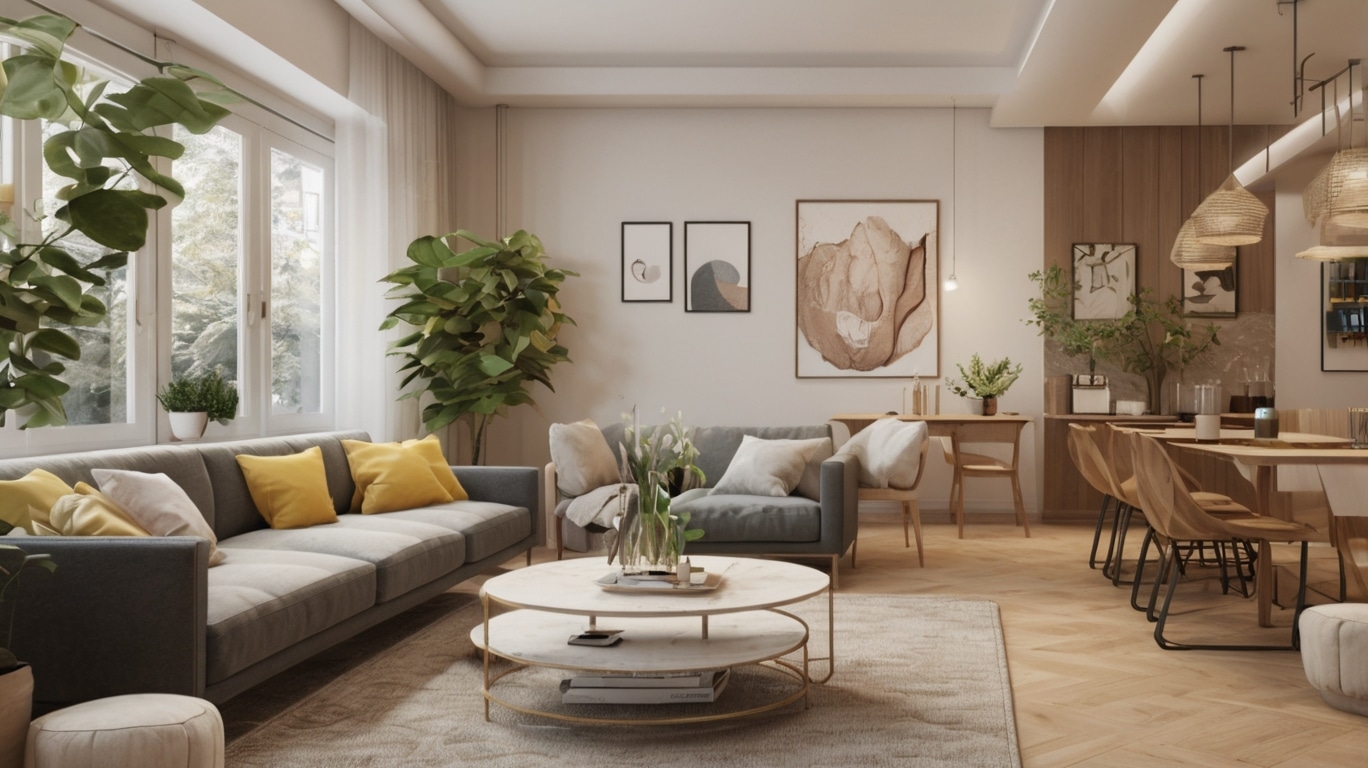A narrow space is a designer’s worst enemy and best friend. Bit weird, yeah but hear me out. It forces you to get creative in ways you never planned. One minute you’re frustrated, the next you’re measuring every inch like it’s gold.
So when your living room and dining room have to share one slim space? Game on. It’s all about tricks, illusions, and a little bit of “no one will notice if the chairs are from two different sets.”
Let’s dive into some fresh, no-fluff ideas that’ll help your long, narrow combo space look less like a corridor and more like a cozy dream.
1. Use a Slim Sofa as a Room Divider
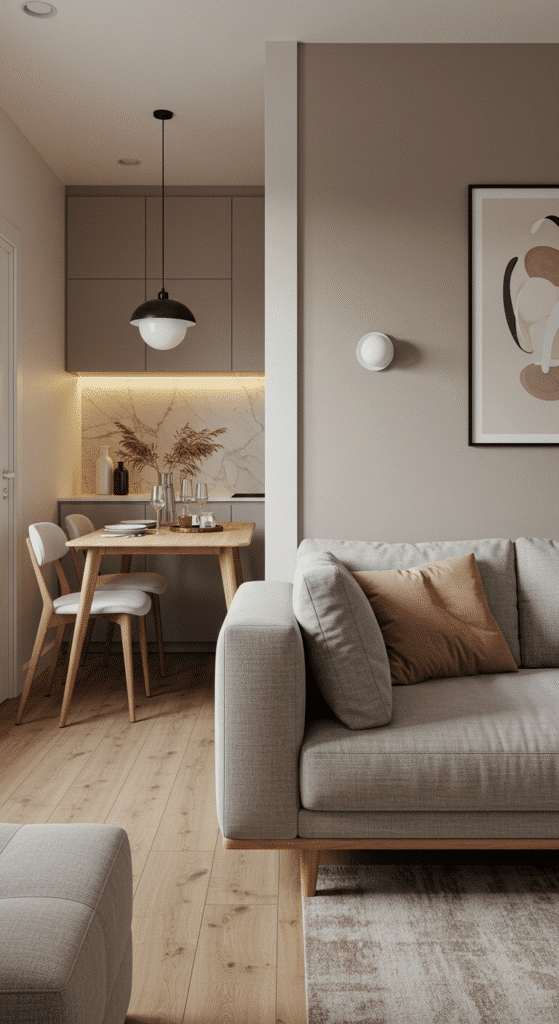
Who said you need walls to split a space? A slim-profile sofa can do the trick. Place it with its back facing your dining area boom, invisible line drawn.
It helps the eye know where the “living” ends and the “dining” begins. Plus, it doesn’t block the flow. Heavy couches? Nope. We’re skipping those. Look for something with tall legs. It adds air under the sofa, so the room doesn’t feel squished.
Pro tip? Throw a rug under the living room side. Double line drawn. You’re officially a space magician now.
2. Go Round with the Dining Table
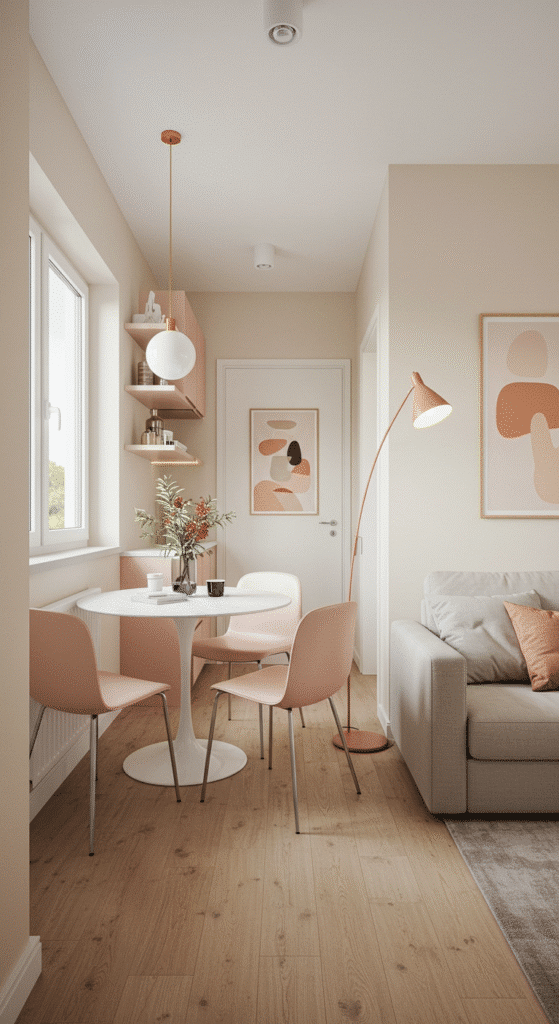
Square room, round table. Always a win. In narrow spaces, sharp corners mess with the vibe. A small round table softens things, makes movement easier. No thigh bruises. No drama.
You can tuck it in the corner or near a window. Add two chairs or four depending on how many people you like. Or tolerate. Foldable round tables? They exist. And they’re brilliant if your dining area is part-time only.
3. Match Colors Across the Space

Here’s a trick so sneaky, it feels like cheating. Use the same color scheme in both “rooms.” That dusty blue throw? Match it with your dining chair cushions. Or the wood tone in your coffee table? Mirror it in your dining bench.
It pulls the eye across the space without confusion. Like one long sentence instead of two choppy ones. Your brain just gets it. Mix up textures though. Too matchy-matchy feels like a showroom. And nobody wants that.
4. Go Vertical or Go Home
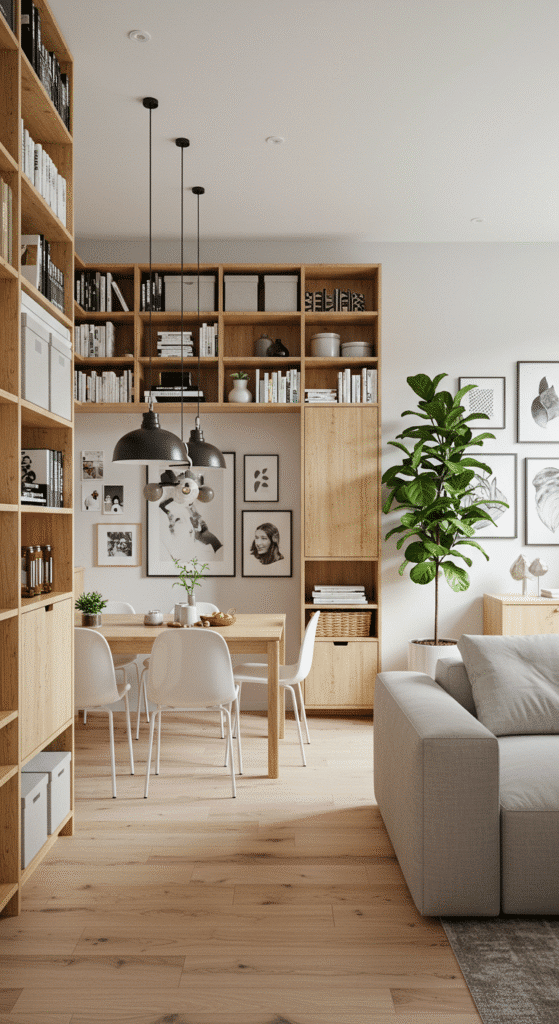
When you don’t have square footage, height is your best friend. Add floating shelves above your sofa. Or a vertical wine rack in the dining corner.
Tall curtains that go ceiling to floor? Chef’s kiss. They stretch the room visually. Even if your windows are short, fake it. Hang the rods higher.
Get a tall plant. It breaks the line of sight. Suddenly the room doesn’t feel like it’s closing in. Just don’t go for a wide bushy one. You want up, not out.
5. Use a Long Rug to Stretch the Space
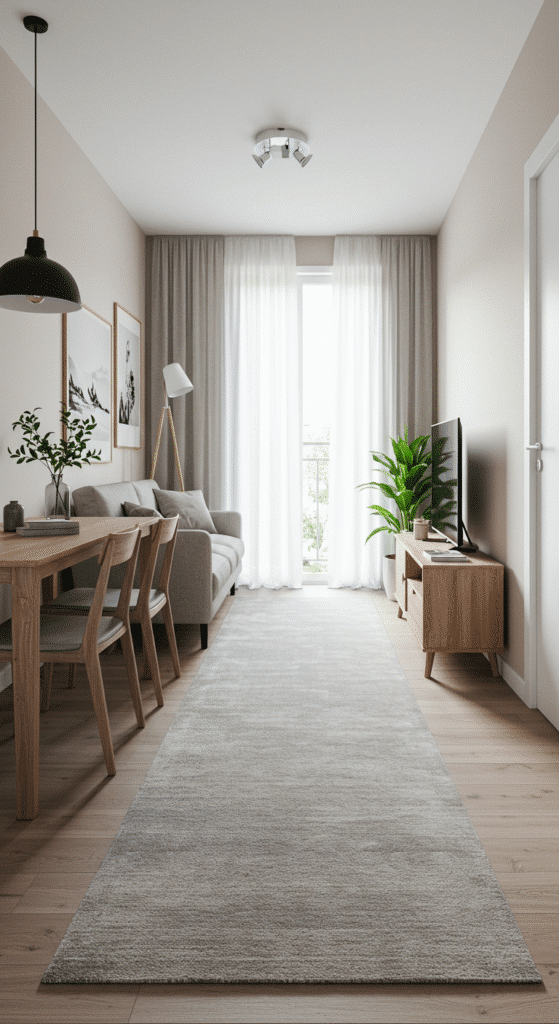
Narrow room = runway rug. One long rug that runs through both the living and dining zones makes everything feel connected. It leads the eye down the space like a yellow brick road. Except it’s your tastefully neutral jute or distressed Persian.
Make sure the rug touches furniture in both areas. It’s like glue. Invisible, classy glue. Skip the multiple small rugs. Too choppy. Too busy. Unless chaos is your aesthetic in which case, go wild.
6. Invest in Multi-Purpose Furniture
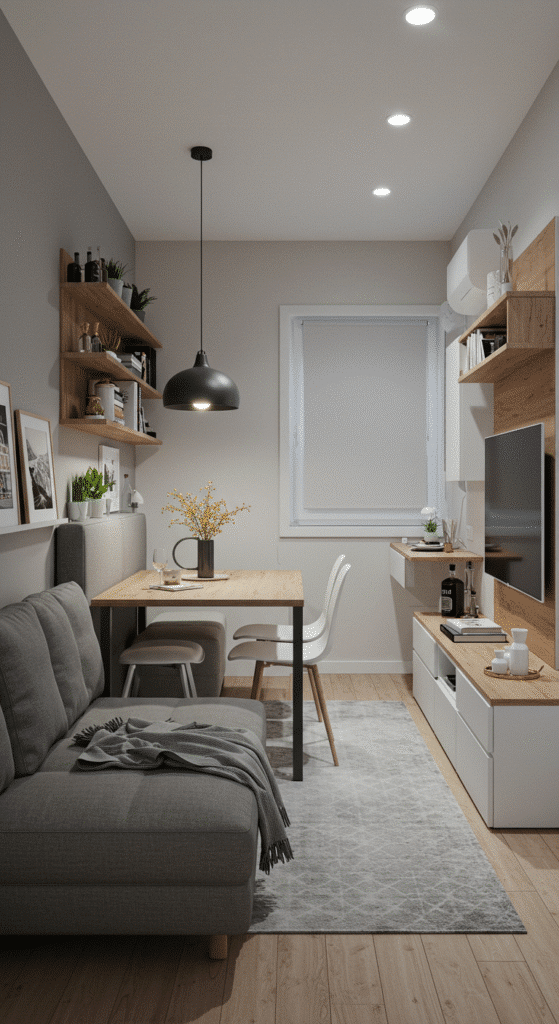
If your dining table can’t double as a desk or buffet, what even is it?
In narrow spaces, everything needs a side hustle. Benches instead of chairs? Slide ‘em under the table when not in use. Instant walking space.
Storage ottomans in the living area? Boom coffee table, seating, and clutter hiders. You win again.
Wall-mounted folding desks or pull-out leaves on tables also do wonders. You’ll feel like James Bond every time you open them. Just with less tuxedo, more toast crumbs.
7. Think in Zones, Not Walls
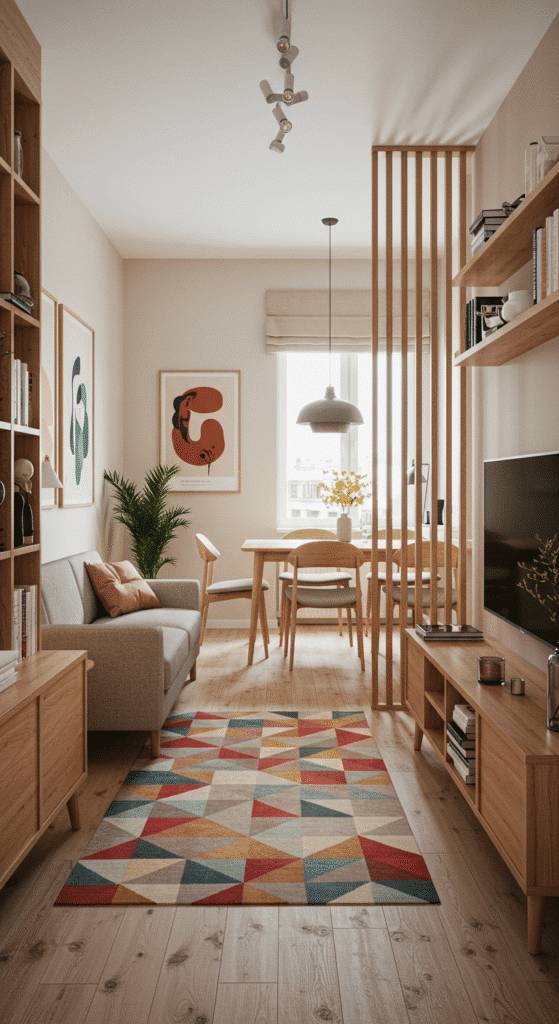
Just because the room is one shape doesn’t mean the functions have to blur together. Create visual zones.
Pendant light over the dining table? Zone set. Floor lamp near the sofa? Another one. Different but coordinating rugs for each area? It’s like invisible fencing for furniture.
You could even use art. Hang one big piece over the dining wall and a gallery layout over the sofa. Boom. Instant separation, no drywall needed.
8. Keep Things Off the Floor
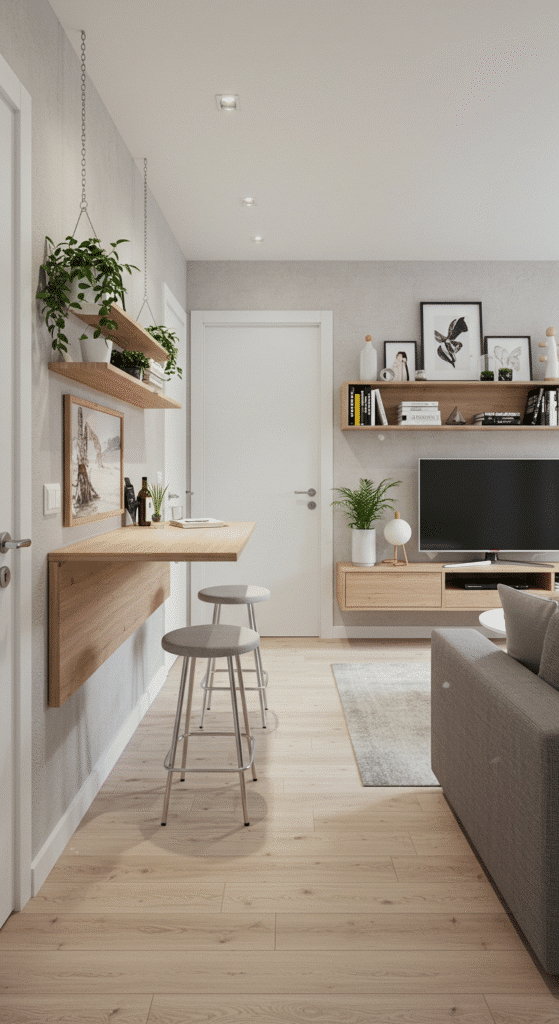
This one’s underrated: float everything you can.
Wall-mounted shelves, floating TV units, even floating dining benches. When you can see more floor, the room breathes. It sighs in relief.
Cabinets that hover a few inches above the ground still store all your junk but feel lighter. Bonus? Easier to clean under.
Keep furniture legs slim and airy too. Think mid-century, not farmhouse chunk.
9. Use Mirrored or Glass Pieces
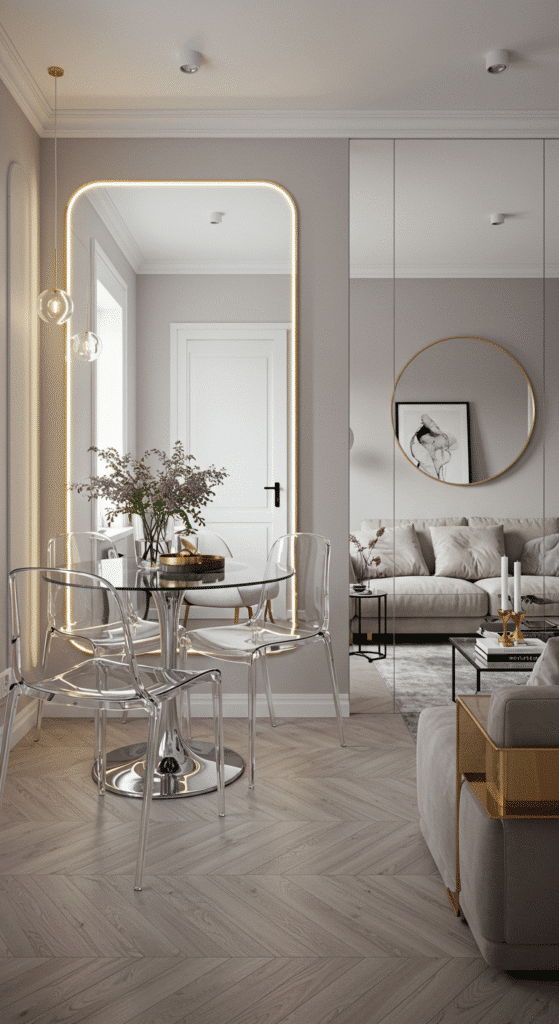
Glass is basically furniture that disappears. In a good way.
A glass coffee table? You see the rug under it, so it doesn’t visually crowd the space. Same with a mirror above the sofa or on the dining wall.
Mirrors bounce light and fake space like nothing else. Go big. Or group a few vintage ones if you’re the artsy type.
Glass dining table? Risky with toddlers, sure. But otherwise space hack gold.
10. Keep the Palette Light, but Don’t Fear Contrast
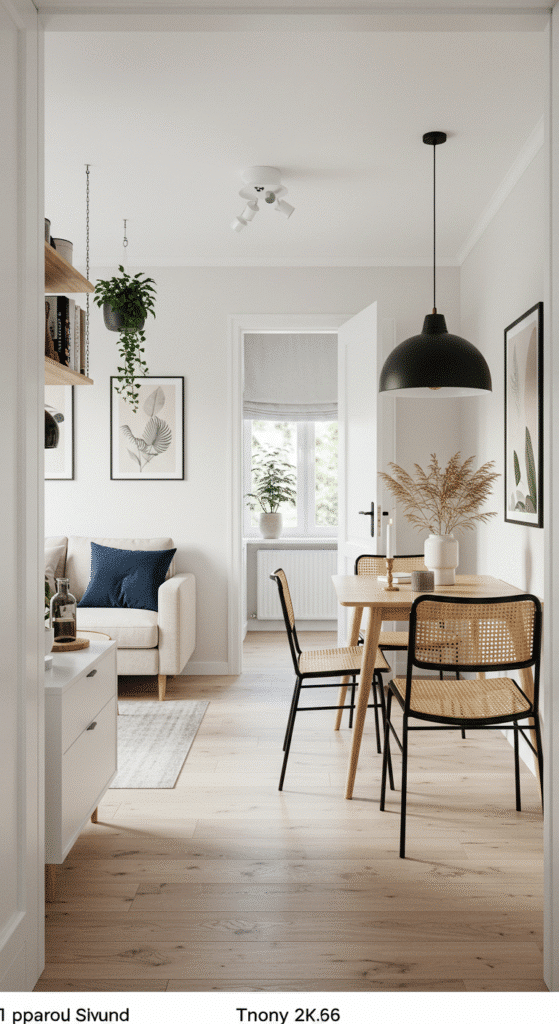
White walls aren’t boring—they’re canvas. They let everything else breathe. But don’t go all marshmallow.
Add contrast with dark frames, moody cushions, or a bold chair. It keeps the space from feeling like a hospital waiting room.
If you love color, fine just keep it contained. Pick a few accent tones and echo them in small, surprising places. Like a mustard napkin on the table. Or a moss green book on the shelf.
It’s about balance, not blandness.
11. Corner Banquette Seating to Save Space
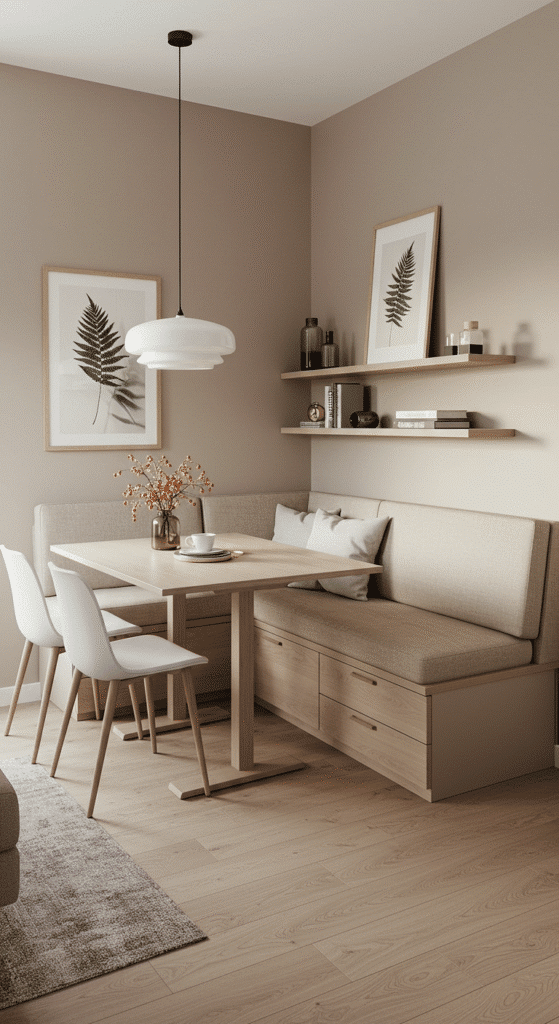
Corners are dead zones if you don’t wake ‘em up.
Instead of placing a traditional dining set in the middle, go for a banquette in the corner. L-shape it. U-shape it. Whatever fits.
Cushions make it cozy, and the wall does half the work. Bonus? You can tuck storage drawers under the seats. Hide all your secrets well, dinnerware and old chargers at least.
Suddenly, a boring corner becomes a social nook. Your guests won’t even miss the chairs.
12. Mount a Fold-Down Table on the Wall
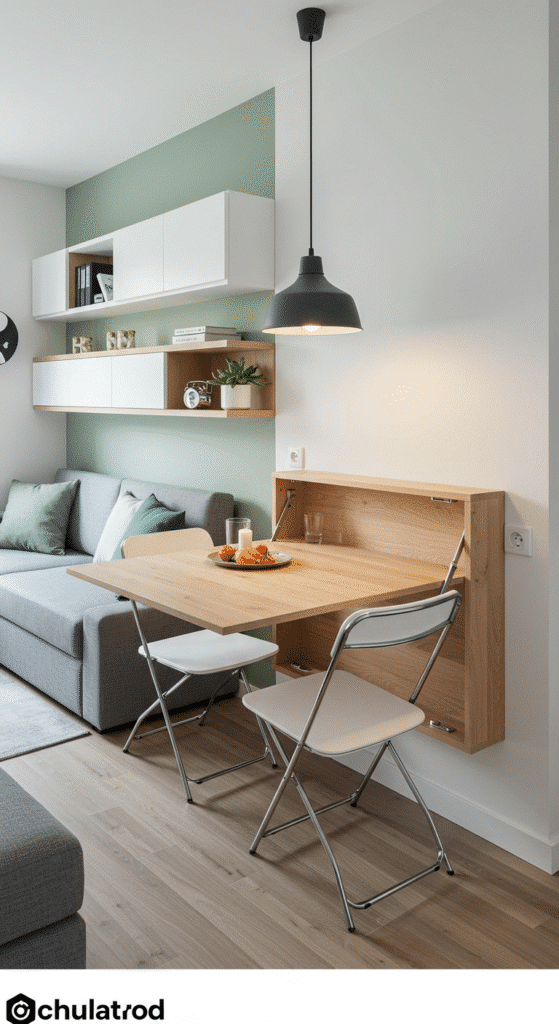
This one’s for the bold minimalists. You can literally fold away your dining space like origami.
A wall-mounted drop-leaf table flips down when needed, then disappears when not. Great for tight traffic areas or if you like to dance in your living room. No judgment.
Pair it with stackable stools or slim foldable chairs. Hook ‘em on the wall too if you wanna feel like a restaurant owner on the go.
This move screams clever, not cramped.
13. Use Transparent or Open-Frame Furniture
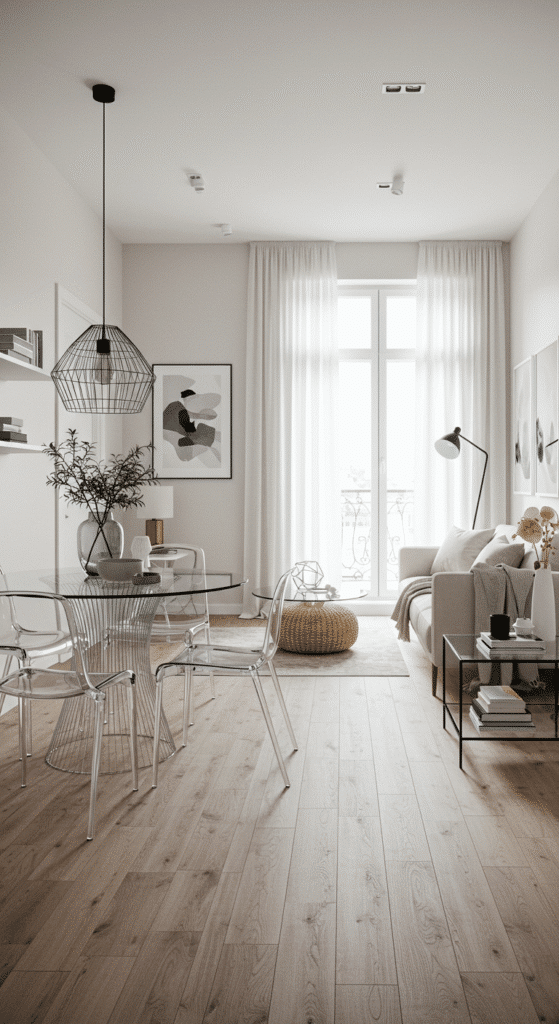
Solid furniture blocks space. It’s like a wall you didn’t ask for.
Instead, go for chairs, tables, and shelving that have open frames. Think wire chairs, acrylic side tables, ladder-style bookshelves.
It lets your eye travel all the way through the room, no stops. Your brain reads “airy” instead of “tight.”
And hey—makes vacuuming easier too. You’re welcome.
14. Align Furniture Along One Wall
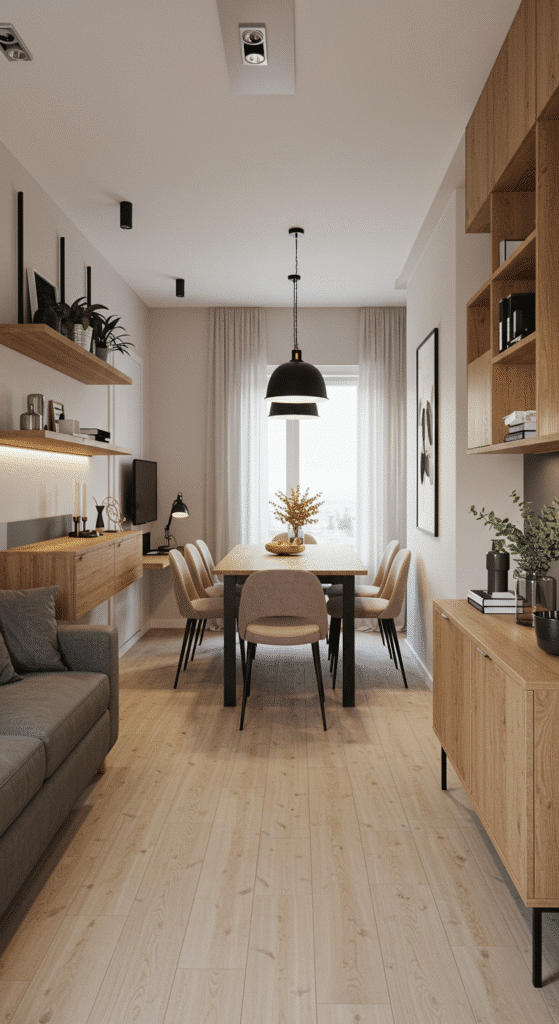
Instead of splitting the room vertically (length-wise), try aligning both living and dining areas on one side.
Yes, stack ’em like a subway train.
Dining table up first, maybe a small console in between, then sofa or loveseat after. Keep it sleek, not clunky.
It opens up the other side of the room like a runway. You’ve got breathing room now. That long “hallway” feel? Gone.
15. Make a Mobile Dining Setup
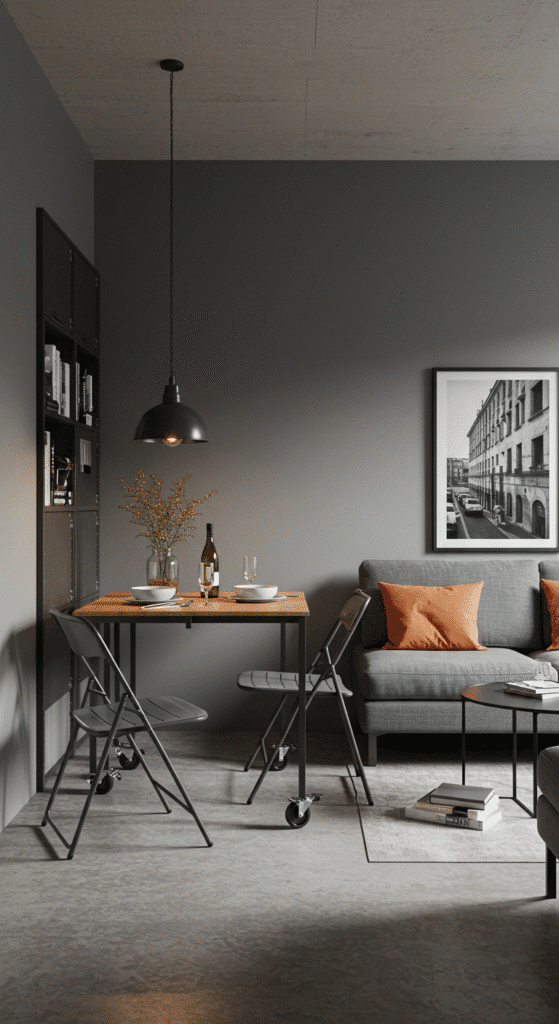
What if your dining setup… moved?
Use a table on wheels, or a light-weight one you can slide easily. Same goes for chairs. Tuck them away near the wall when not in use. Roll the table in when dinner’s on.
You can even switch things up based on mood. Dining near the window today, by the kitchen tomorrow. No rules.
It’s like living with transformer furniture. And yes—it’s oddly fun.
16. Double-Sided Open Storage to Divide the Space

Instead of a sofa or rug, use an open bookshelf as a divider.
Face it one side toward the sofa, one side toward the dining area. Use it for books, plants, plates, or random decorative things you forgot you owned.
Since it’s open, it won’t block light or sightlines. But it still defines two zones.
Plus, more storage. Always a win.
17. Add a Floating Buffet or Sideboard
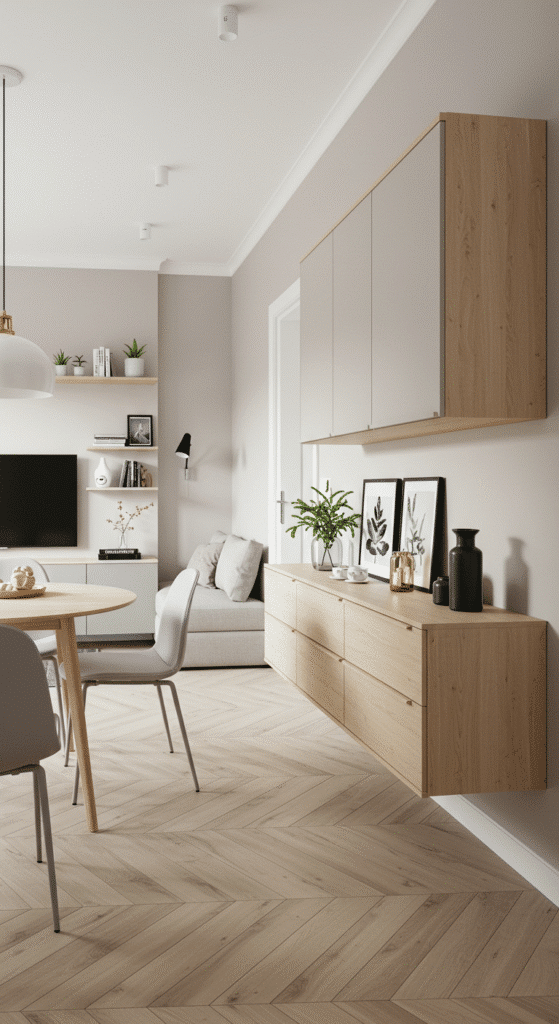
A traditional buffet takes up floor space—no bueno. But a floating one? That’s the future.
Mount a slim sideboard or narrow console table on the wall in the dining area. Store cutlery, napkins, candles, whatever. You could even stick a coffee machine on top.
You keep your surface space and still get function. Feels high-end, even if you DIY’d it at 2am.
18. Make the TV a Disappearing Act
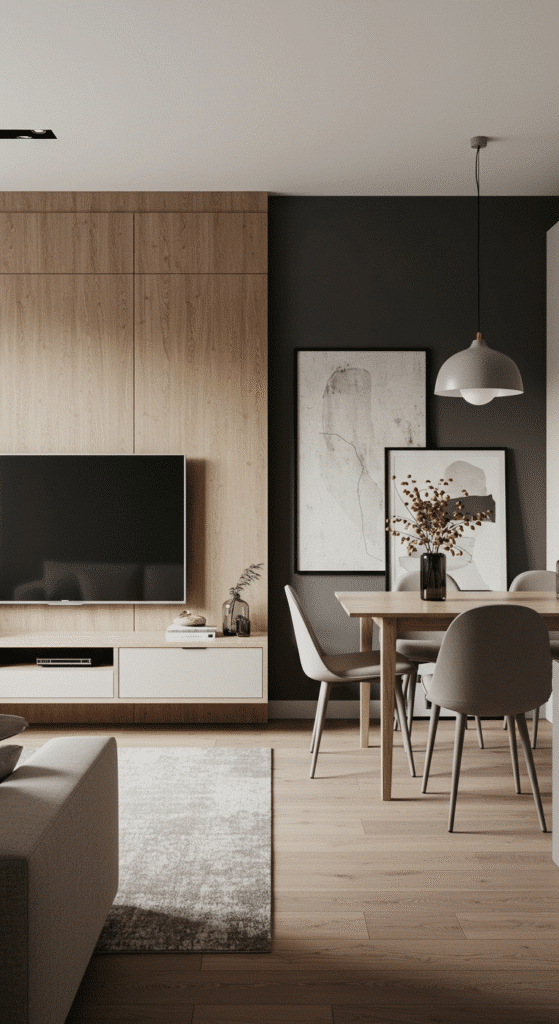
Here’s one for people who don’t want their TV taking over the whole living room.
Use a cabinet that lets you slide the TV in and out. Or mount it on a swivel bracket that tucks away when not in use. Heck, even a projector and retractable screen work if you’re fancy like that.
This way, the dining side doesn’t feel like it’s eating next to Netflix. Boundaries, people. Even your gadgets need ‘em.
19. Mirror the Layout Symmetrically
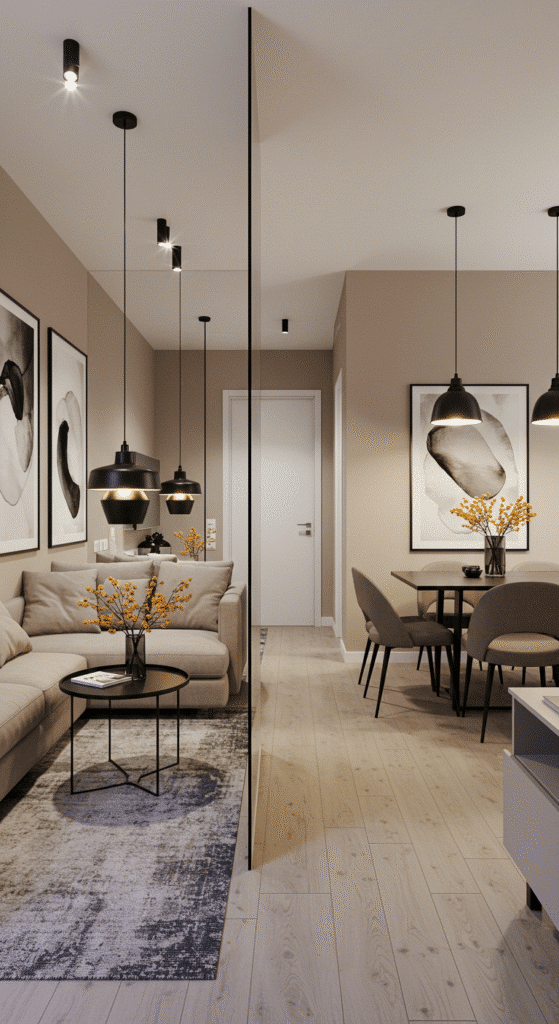
Sometimes symmetry is your space’s best friend.
Try mirroring both zones—same width, same shapes, just reversed. Dining table on the left with two chairs facing in. Sofa on the right with a narrow coffee table. Balance creates calm, even if the room’s small.
If done right, it feels intentional. Not improvised.
Just don’t overthink it. Keep decor simple and let the balance speak.
20. Paint or Wallpaper Just One End
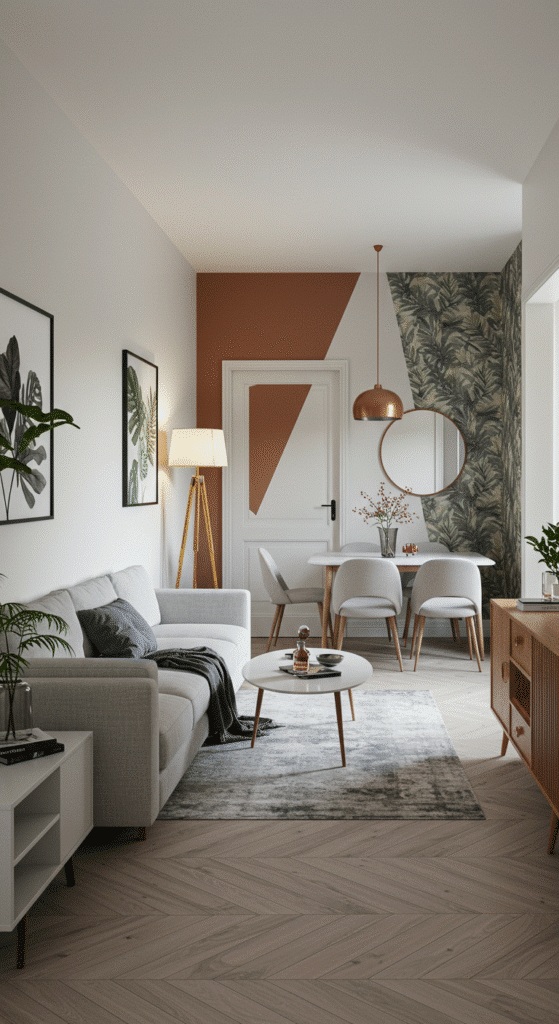
Got one shorter wall behind your dining table or sofa? Paint it something bold. Or wallpaper it with something funky.
This creates an anchor. Suddenly the room has direction. It knows where to begin and end.
People focus less on the narrowness and more on that bold pop of color or texture.
It’s like saying, “Hey, yes, this room is skinny but it’s got style. And it owns it.”
Final Thoughts
Look, narrow rooms are tricky. They can feel awkward and tight and unfair. But when you work with them not against them you get something special. Like a little puzzle you solved with your hands and heart.
Don’t overfill the space. Leave room to breathe. And let your personality show. Mix high and low. Match and mismatch. Live a little.
Because at the end of the day, it’s your home. Your weirdly-shaped, charming, narrow-living-dining-room-combo kind of home. And that’s what makes it awesome.

